Testing The World’s Best APUs: Desktop AMD Ryzen 4750G, 4650G and 4350G
by Dr. Ian Cutress on December 16, 2020 10:30 AM ESTCPU Benchmarks: Real World
All of our benchmark results can also be found in our benchmark engine, Bench.
Agisoft Photoscan 1.3.3: link
The concept of Photoscan is about translating many 2D images into a 3D model - so the more detailed the images, and the more you have, the better the final 3D model in both spatial accuracy and texturing accuracy. The algorithm has four stages, with some parts of the stages being single-threaded and others multi-threaded, along with some cache/memory dependency in there as well. For some of the more variable threaded workload, features such as Speed Shift and XFR will be able to take advantage of CPU stalls or downtime, giving sizeable speedups on newer microarchitectures.
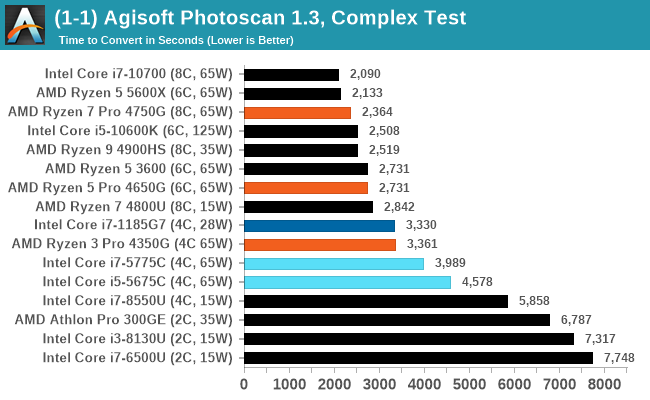
NAMD 2.13 (ApoA1): Molecular Dynamics
One of the popular science fields is modeling the dynamics of proteins. By looking at how the energy of active sites within a large protein structure over time, scientists behind the research can calculate required activation energies for potential interactions. This becomes very important in drug discovery. Molecular dynamics also plays a large role in protein folding, and in understanding what happens when proteins misfold, and what can be done to prevent it. NAMD, or Nanoscale Molecular Dynamics, has already been used in extensive Coronavirus research on the Frontier supercomputer. Typical simulations using the package are measured in how many nanoseconds per day can be calculated with the given hardware, and the ApoA1 protein (92,224 atoms) has been the standard model for molecular dynamics simulation.
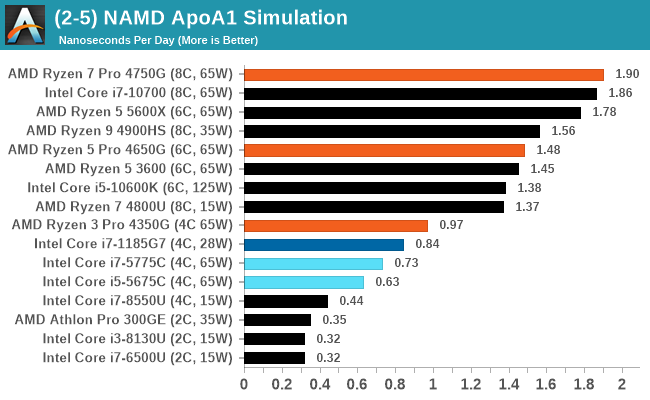
Blender 2.83 LTS: Link
One of the popular tools for rendering is Blender, with it being a public open source project that anyone in the animation industry can get involved in. This extends to conferences, use in films and VR, with a dedicated Blender Institute, and everything you might expect from a professional software package (except perhaps a professional grade support package). With it being open-source, studios can customize it in as many ways as they need to get the results they require. It ends up being a big optimization target for both Intel and AMD in this regard.
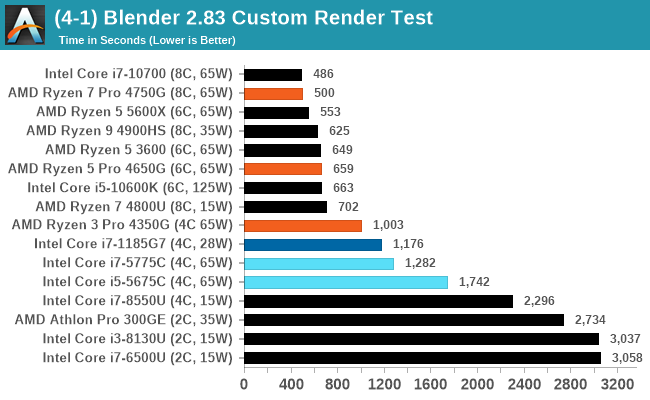
Corona 1.3: Link
Corona is billed as a popular high-performance photorealistic rendering engine for 3ds Max, with development for Cinema 4D support as well. In order to promote the software, the developers produced a downloadable benchmark on the 1.3 version of the software, with a ray-traced scene involving a military vehicle and a lot of foliage.
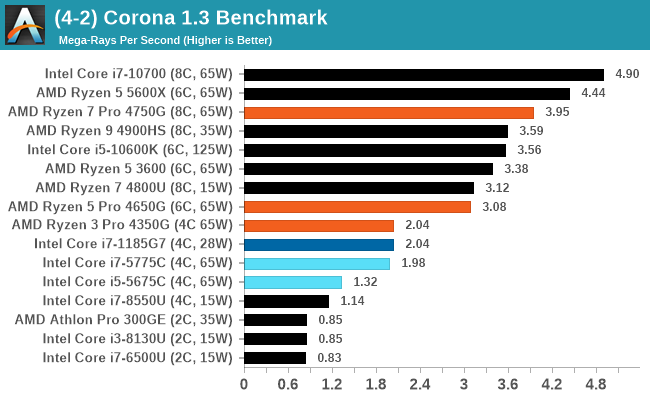
POV-Ray 3.7.1: Link
A long time benchmark staple, POV-Ray is another rendering program that is well known to load up every single thread in a system, regardless of cache and memory levels. After a long period of POV-Ray 3.7 being the latest official release, when AMD launched Ryzen the POV-Ray codebase suddenly saw a range of activity from both AMD and Intel, knowing that the software (with the built-in benchmark) would be an optimization tool for the hardware.
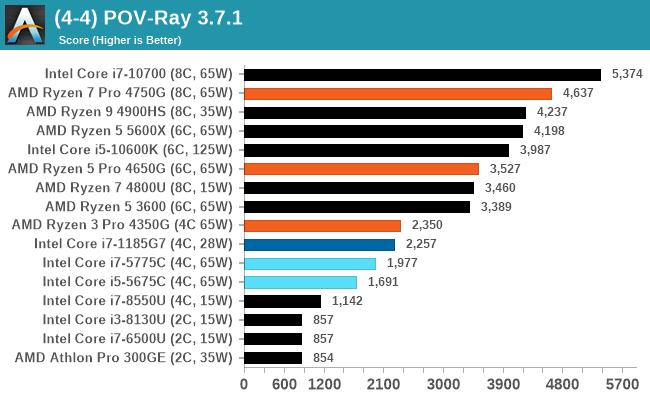
V-Ray: Link
We have a couple of renderers and ray tracers in our suite already, however V-Ray’s benchmark came through for a requested benchmark enough for us to roll it in. Built by ChaosGroup, V-Ray is a 3D rendering package compatible with a number of popular commercial imaging applications, such as 3ds Max, Maya, Undreal, Cinema 4D, and Blender.
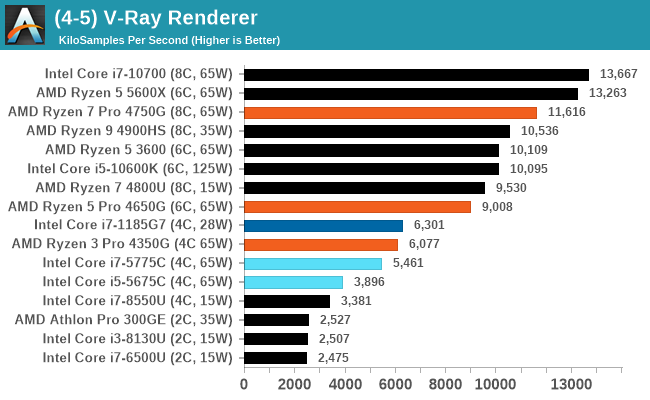
HandBrake 1.32: Link
Handbrake is a favored tool for transcoding, with the later versions using copious amounts of newer APIs to take advantage of co-processors, like GPUs. It is available on Windows via an interface or can be accessed through the command-line, with the latter making our testing easier, with a redirection operator for the console output. We take the compiled version of this 16-minute YouTube video about Russian CPUs at 1080p30 h264 and convert into a 480p30 ‘Discord’ format.
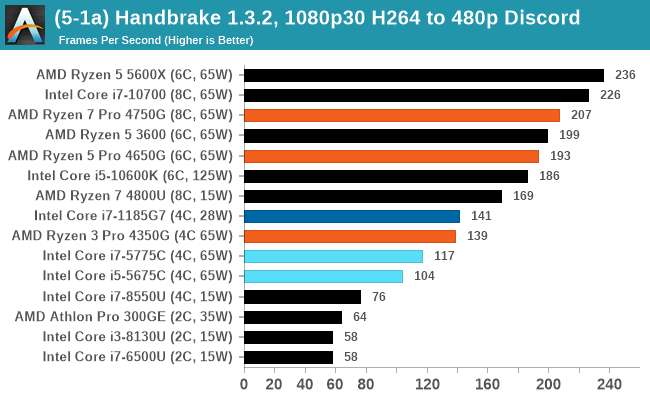
7-Zip 1900: Link
The first compression benchmark tool we use is the open-source 7-zip, which typically offers good scaling across multiple cores. 7-zip is the compression tool most cited by readers as one they would rather see benchmarks on, and the program includes a built-in benchmark tool for both compression and decompression.
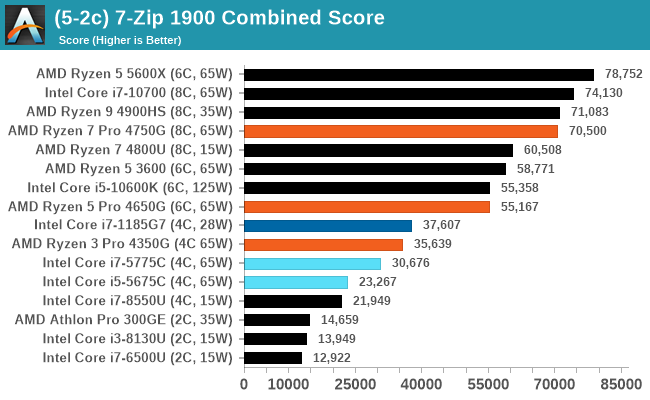
AES Encoding
Algorithms using AES coding have spread far and wide as a ubiquitous tool for encryption. Again, this is another CPU limited test, and modern CPUs have special AES pathways to accelerate their performance. We often see scaling in both frequency and cores with this benchmark. We use the latest version of TrueCrypt and run its benchmark mode over 1GB of in-DRAM data. Results shown are the GB/s average of encryption and decryption.
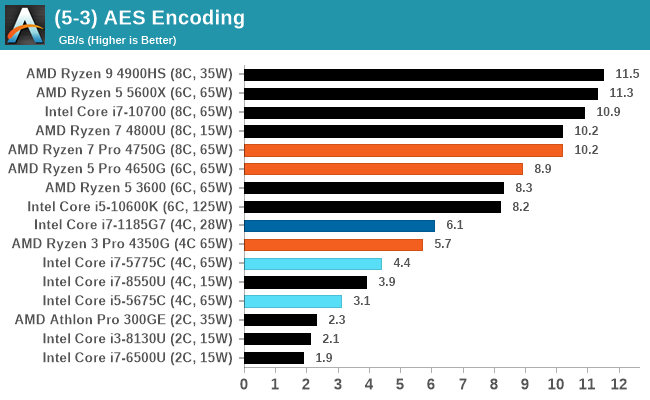
WinRAR 5.90: Link
For the 2020 test suite, we move to the latest version of WinRAR in our compression test. WinRAR in some quarters is more user friendly that 7-Zip, hence its inclusion. Rather than use a benchmark mode as we did with 7-Zip, here we take a set of files representative of a generic stack – a micture mixture of compressible and incompressible formats
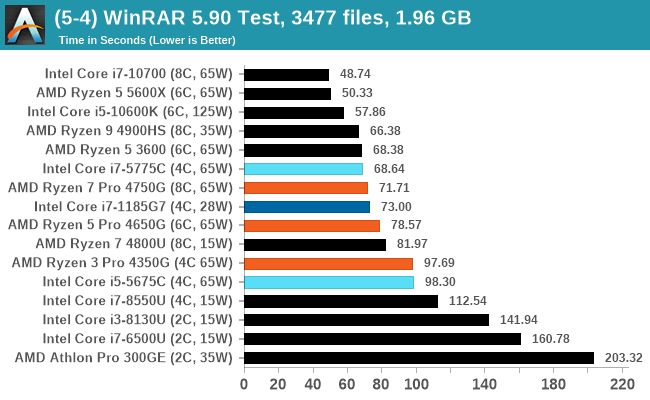
Mozilla Kraken 1.1
Kraken is a 2010 benchmark from Mozilla and does a series of JavaScript tests. These tests are a little more involved than previous tests, looking at artificial intelligence, audio manipulation, image manipulation, json parsing, and cryptographic functions. The benchmark starts with an initial download of data for the audio and imaging, and then runs through 10 times giving a timed result.
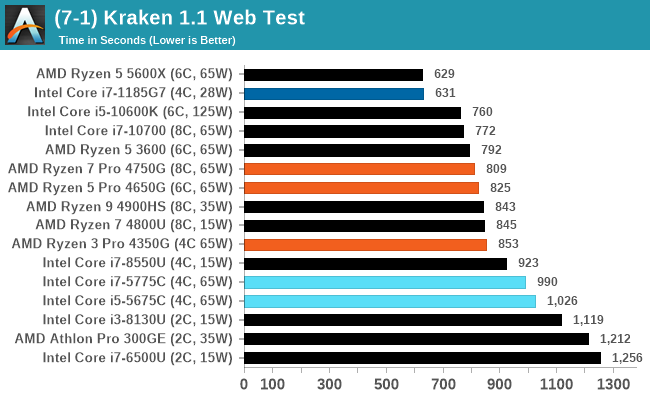
Google Octane 2.0
Our second web test is also JavaScript based, but uses a lot more variation of newer JS techniques, such as object-oriented programming, kernel simulation, object creation/destruction, garbage collection, array manipulations, compiler latency and code execution.

Speedometer 2: JavaScript Frameworks
Our newest web test is Speedometer 2, which is a test over a series of JavaScript frameworks to do three simple things: built a list, enable each item in the list, and remove the list. All the frameworks implement the same visual cues, but obviously apply them from different coding angles.
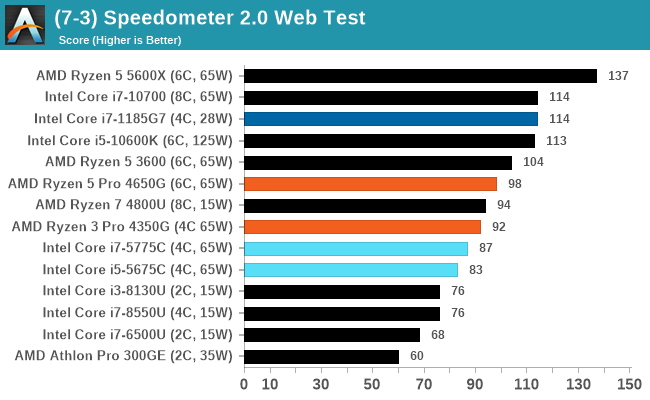










104 Comments
View All Comments
Kuhar - Thursday, December 17, 2020 - link
I guess you two guys didn`t read the article, did you?! It states clearly about memory SPEED and about memory TIMINGS.29a - Thursday, December 17, 2020 - link
I know, it sucks. The reasoning is they think people who build their own computers wont go into the BIOS and enable XMP.BlueScreenJunky - Thursday, December 17, 2020 - link
My conclusion is that we need better low Power Consumption discrete GPUs. The GT1030 is over 3 year old and still faster than IGPs. If nvidia could release an RTX 3030 with a 30W TDP it would be perfect for small machines.nero10578 - Thursday, December 17, 2020 - link
Why would you not test 720p which is what people use integrated GPUs for? 1080p high is too high and 360p is well no one plays at that resolution. Also wouldn't it be better to test the GT 1030 using the APUs? To remove any performance differences coming from the CPU side which from a 2600 to a 4750G is massive.Fujikoma - Thursday, December 17, 2020 - link
Thank you for the review. These are typically the types of processors I use to build systems for older family members. Almost exclusively used for web-surfing, online purchases, You-Tube, Facebook, Office/Libre, burning music cds, simple/archaic games, and one individual using Photoshop. I will agree, as others have stated, that 720P really should be the minimum monitor size. Mainly because it's more expensive to find a monitor with lower resolution than a cheap 720P/768P/1080P LCD. I don't mind the 1080P max tests because it's nice to see what kind of a brick wall the iGPU will be hitting. I just finished computer builds for my brother and ex-wife, which left replacing other family from really old APUs systems. Now I know why I don't see much of a selection anymore. Shame, because I enjoy DIY over buying a basic box from an OEM and this just makes it more of a hassle.Superunknown9898 - Thursday, December 17, 2020 - link
Anyone else notice the Ryzen 4750G struggling to beat the 3600X in games but dominating in a few office benchmarks? I figured the 4750G would make a clean sweep seeing as it runs at identical frequencies to the 3600X but has more L1 and L2, two more cores plus a monolithic die.maindan - Thursday, December 17, 2020 - link
What a gross oversight not to include the new Apple M1 CPU here, which is essentially an APU.Inexcusable.
qlum - Thursday, December 17, 2020 - link
Not really the area of focus for anandtech but the 4700g has a small niche as being the best cpu for memory frequency records.Shivansps - Thursday, December 17, 2020 - link
I just logged in to say thtas the wrong way to way IGP perf... Resolutions for IGP are 720P/768P min/med and 900P min/med depending on the game, 1080p full is too much and anything below 720p is worthless. 900P tend to be the sweetspot in performance and quality for IGP, but not every game can be run at that resolution.Jacek Jagosz - Thursday, December 17, 2020 - link
Are those CPUs even supported on B450? ITX boards are much more expensive on B550 than B450, and if you want a PC with only APU inside then you don't want to spend too much on it.